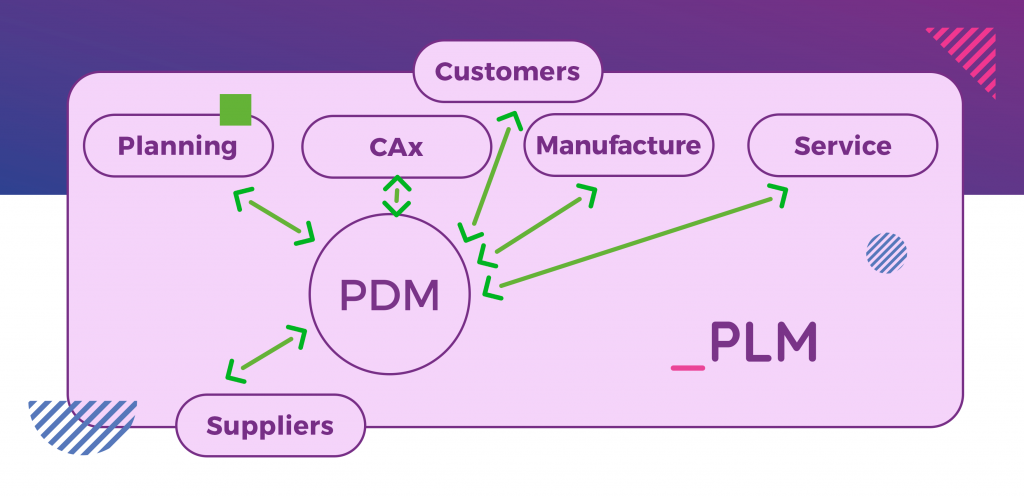Welcome to the dynamic realm of product design and development, where two powerhouses distinctly stand out – Computer-Aided Design (CAD) and Product Lifecycle Management (PLM).
As a formidable pair, these breakthrough technologies are significantly redefining how products are conceived, designed, developed, and launched into the market.
In this feature, we will delve into CAD and PLM transformative powers in a rapidly evolving industry. Get ready as we uncover how these tools are reshaping the process of turning vision into functional reality!
CAD and PLM – The Game-changing Duo in Product Design
The right tools make all the difference, and in the landscape of product design, that distinction goes to CAD and PLM. Computer Aided Design (CAD) aids in crafting precise, detailed 3D models of products digitally. It allows designers to test their ideas extensively before even creating a prototype. It’s like having a digital sandbox where all designs can be tried, tested, and tinkered with.
Meanwhile, Product Lifecycle Management (PLM) takes care of the journey that products go through from inception to retirement. It looks over stages such as concept development, manufacturing process planning, supply chain management support, and more. Managing product information at every stage efficiently ensures smoother functionality across the board.
These two combined provide a robust infrastructure for designing and developing products in today’s fast-paced industries.

The Digital Revolution – Switch to CAD and PLM
The leap from traditional methods to cutting-edge technologies like CAD and PLM is akin to a paradigm shift, improving the way numerous industries function. It’s less time-consuming and reduces errors, given that everything is done digitally. Detailed blueprints can be created in less time, reducing the cycle of product development.
For instance, the automotive industry can leverage CAD software such as Creo for its real-time simulation features. You might even compare Creo against SolidWorks in CAD software features as both offer great enhancements for complex design tasks. Similarly, PLM software plays a crucial role in managing product data across various phases of production.
Adopting these digital tools provides a competitive edge by streamlining operations and enhancing efficiency.
Maximizing Efficiency with CAD and PLM
The fusion of CAD and PLM brings forth an environment that’s highly efficient and productive. Here are a few ways they deliver maximized efficiency:
- Precision: With CAD, every tiny detail within a product design can be elaborately worked upon. This precision reduces the likelihood of errors in the manufacturing process.
- Integration: When it comes to bridging gaps between different stages of product development, PLM plays a pivotal role. It integrates all phases into one cohesive unit.
- Streamlined Process: From mock-up to final product, each step is meticulously managed by both CAD and PLM, ensuring smooth progression without unexpected hurdles.
- Time Management: Both these tools save precious hours by reducing manual paper trail, automating tasks, and facilitating easy information access.
Fundamentally, these benefits lead to better products with less expenditure of resources – the end goal for any industry.
Transforming Visions into Reality with CAD and PLM
Increasingly, CAD and PLM are being seen as the tools to take an idea from the drawing board into the real world. This transformative power is owed to their capabilities such as:
- Visualization: CAD software transforms abstract ideas into tangible, 3D elements that can be scrutinized from every angle.
- Collaboration: PLM serves as a nodal point where all stakeholders can collaborate effectively. It provides a single source of truth for everyone involved, fostering great leaders and better teamwork.
- Iterative improvement: Both CAD and PLM allow for rapid prototyping and swift iterations based on feedback. These continual iterations help refine the ultimate product to match its intended vision perfectly.
Concepts are shaped, molded, constructed, deconstructed, changed, and improved upon until they meet their ideal form – effectively turning mere concepts into functional realities.
The Perfect Pair for Product Innovation
CAD and PLM are making waves by enabling product innovation to new heights. With CAD, designers can experiment with different designs, simulate operating conditions, and analyze performance even before creating a physical prototype. This marks a significant advancement in product design, permitting improvements and optimization at an early stage.
On the other hand, PLM is empowering firms to efficiently handle the lifecycle of their products from their inception, through the design and manufacturing phases, all the way to their service life and decommissioning. In essence, novel ideas rise elegantly into fruition with this pair propelling product innovation.
The New Forefront of Design and Development
It’s apparent that CAD and PLM are reshaping our approach to design and product development. Bridging the gap between idea incubation and market delivery, they empower industries to navigate complex processes effortlessly.
As innovative tools that are charting a new course for future development, CAD and PLM are transforming dreams into actualities. Harnessing these technologies signals not just survival in today’s competitive marketplace but signifies a step towards future growth and success.
Conclusively, mastering the combo of CAD and PLM could be your pathway to being a game-changer in your industry.





